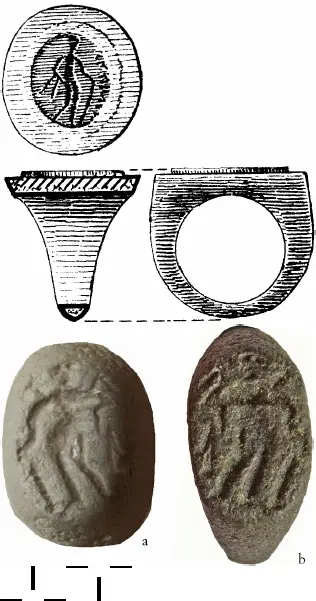Just imagine
doing some excavations in the middle of the Ganges Valley
to find hundreds of seals carrying the image of Greek gods and goddesses such
as Athena, Apollo, Nike, and Herakles!
[Agate intaglio from Phu Khao Thong (right), impression (left). H. 16 mm.
Photos: Brigitte Borell and Prachak Pongspanich]
The discovery of the figure of Herakles, in particular, is very
striking and recognizable as he is resting on a club and holding a lion skin.
He appeared from excavations in the 1940s at Rajghat, close to the Varuna and Ganges Rivers
confluence. The site was a well-established trade center in antiquity, with
connections reaching westward to Taxila. Considering that the distance from the Indus Valley,
where Alexander halted
his march eastwards, to the Ganges is almost 1500 km,
shows how far his Greek influence traveled after his death.
The surprise discovery does not stop in India
as pictures of the god Herakles were found as far away as southern Thailand, at the archaeological site of Phu
Khao Thongis – meaning
Golden Hill - on the Isthmus of Kra. The hill
owes its name to the many gold finds resulting from legal and illegal diggings.
This coastal trading post was linked to the maritime networks of the
Indian Ocean and served as a hub for land crossings to the peninsula's east
coast and the South China Sea. The
unearthed artifacts originate from China
and South East Asia to the Mediterranean in
the West. They can be dated to the last centuries BC and early AD. Typical among the finds are, on the one hand, a fragment of a
Roman cameo and a Roman intaglio from the West, and on the other hand, fragments
of bronze mirrors from China’s
Han period (25-220 AD) from the East.
The Herakles from Thailand
is remarkable because its design does not originate in the Mediterranean.
The young beardless Herakles has big eyes and a large nose – hardly the delicate, true-to-nature rendition of the Greeks! It is, however, the work of an
experienced local craftsman and appears to have been made for a finger-ring. This kind of beardless Herakles may be tied to the
days of Alexander the Great,
who used it on his coins. The Graeco-Bactrian King Demetrius I, who ruled from c. 200 until 190 BC, continued the
tradition in his eastern empire.
The main concern for scholars is to note the difference between
local work and imports from the Mediterranean.
This is far from clear-cut, as craftsmen may have settled deeper into Asia, or local craftsmen may have mastered the techniques
from those same settlers.
[Top: Gold ring with glass intaglio from Sirkap, Taxila. H. 22.1
mm
(from Marshall
1951: pl.197)
Bottom: Bronze ring seal and impression (left) from Taxila H. 19 mm.
Taxila Museum, inv. 8797 (Photos: Courtesy of Aman ur Rahman)]
A good example is a ring found in a large hoard of jewelry at Sirkap near Taxila, buried there towards the end of the 1st century
AD. Here, Herakles is presented as a slender and relatively thin figure – a far
cry from the muscular male we would expect. However, it originated from a highly skilled school of gem-engraving. The Herakles seal from Thailand resembles a garnet seal
from the Northwest of the Indian subcontinent, possibly created there as well.
It is now exhibited at the British
Museum. It is noteworthy that it is closely related in
type to two rings from Taxila.
A similar meager Herakles appears on three other seals found in the
Gandhara area in Afghanistan.
Their style also suggests local production.
These are only a few examples of the spreading of Hellenism and
Hellenistic art further East, beyond Alexander's conquered lands. I like to
believe that he would have been delighted with this outcome!
[Pictures are part of the article Herakles on an
Intaglio Seal Found at Phu Khao Thong in the Upper Thai-Malay
Peninsula by Brigitte Borell, published at Academia.edu]


No comments:
Post a Comment